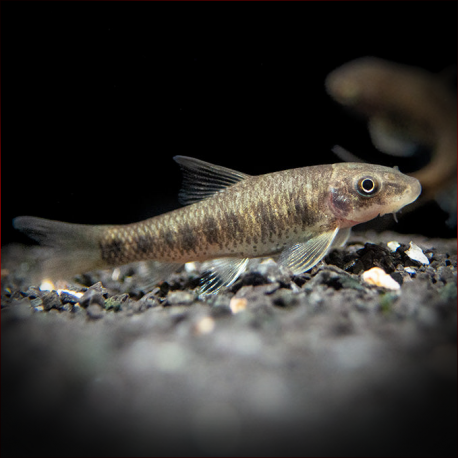More info
Datasheet
| Minimum Tank Size | 80 litres / 21.13 US gallons |
| Maximum Size | 6.9cm / 2.72inches |
| Temperature | 20°C / 68.00°F - 26°C / 78.80°F |
| Hardness | 2.02dgH / 36ppm - 12.05dgH / 215ppm |
| pH | 6.0-7.5 |
General Description
Garra spilota, commonly known as the Garra Spilota, is a visually striking species within the Garra genus. Its unique features include reddish fins, dark blotches on its flanks, and a distinct upper lip structure with soft linings and unculi growths. This species lacks rostral lobes and has specific meristic counts that set it apart from similar species like G. flavatra. The Garra genus is known for frequent taxonomic revisions, reflecting the complexity and wide distribution of its members across southern China, southeast Asia, India, the Middle East, and north/central Africa.
Aquarium Setup
For a healthy environment, setting up an aquarium for G. spilota should mimic a flowing stream or river. Use a mix of water-worn rocks, sand, gravel, and small boulders for the substrate and add driftwood, roots, or branches for decor. Hardy aquatic plants like Microsorum and Anubias species can be included, anchored to the decor pieces. Ensure clean, well-oxygenated water with a high turnover rate, ideally exceeding 10 times per hour. Adequate lighting is crucial for biofilm growth, which serves as a source of nutrition for the fish. Avoid introducing this species to immature tank setups, and provide a secure cover as they have the ability to climb glass.
Behaviour
G. spilota is known for its peaceful nature, making it an excellent addition to a community tank with other Indochinese species from stream habitats. It appreciates the company of its kind, displaying minimal territorial behavior compared to some other Garra species. Maintaining a group of at least 3-4 individuals is recommended to support their social needs.
Feeding and Diet
While G. spilota may graze on algae if available, it is not solely herbivorous. Ensure a varied diet with options like live or frozen chironomid larvae, Tubifex, Artemia, chopped prawn, and quality dried foods rich in vegetable matter. Supplement their diet with fresh fruits, vegetables like cucumber and spinach, and homemade gelatine-bound mixtures for optimal nutrition.
Reproduction & Dimorphism
Information on the reproduction of G. spilota remains unrecorded. Sexual dimorphism in this species is subtle, with males typically displaying slightly more tuberculation on the snout and head. However, this feature is described as rudimentary in G. spilota. Mature females may exhibit a rounder body shape, especially when carrying eggs.
Habitat and Distribution
Endemic to the Rakhine Yoma/Arakan mountains in western Myanmar, G. spilota is primarily found in clear, colorless streams with moderate flow, rocky substrates, and depths up to 0.5 meters. This species shares its habitat with various other fish species, including Garra poecilura, Homaloptera modesta, and Mystus pulcher.
Etymology
The genus name Garra originates from a Gangetic term for "sand-digger," as applied by Francis Buchanan-Hamilton to bottom-dwelling cyprinids. The species name spilota is derived from Ancient Greek, meaning "stained" or "spotted," in reference to its blotched color pattern.

